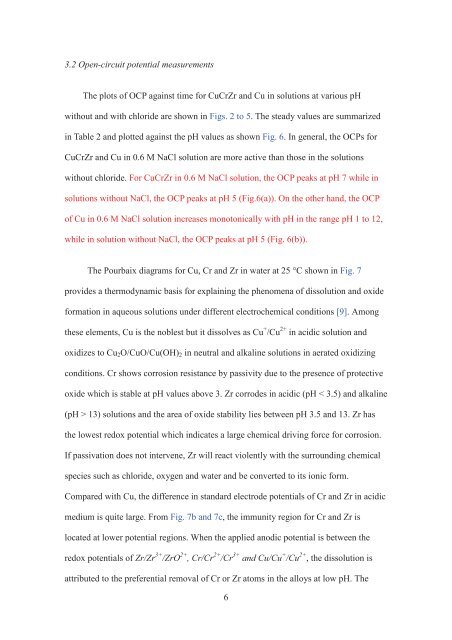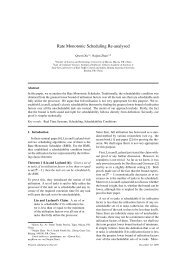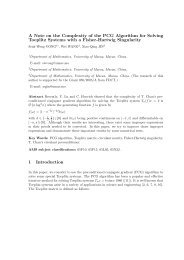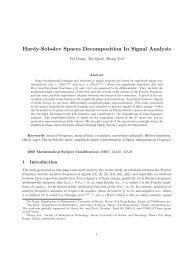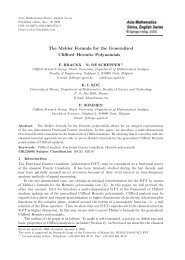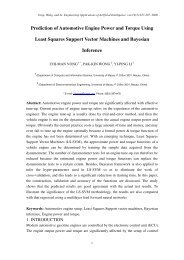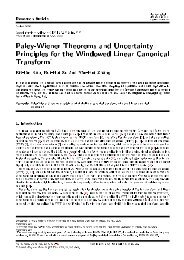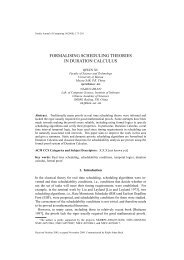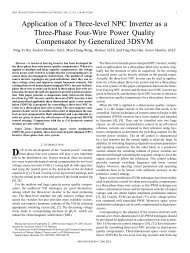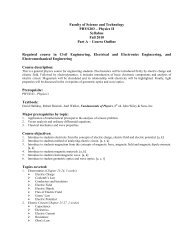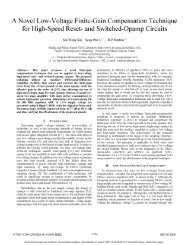Effect of pH on corrosion behavior of CuCrZr in solution without and ...
Effect of pH on corrosion behavior of CuCrZr in solution without and ...
Effect of pH on corrosion behavior of CuCrZr in solution without and ...
Create successful ePaper yourself
Turn your PDF publications into a flip-book with our unique Google optimized e-Paper software.
3.2 Open-circuit potential measurements<br />
The plots <str<strong>on</strong>g>of</str<strong>on</strong>g> OCP aga<strong>in</strong>st time for <strong>CuCrZr</strong> <strong>and</strong> Cu <strong>in</strong> soluti<strong>on</strong>s at various <str<strong>on</strong>g>pH</str<strong>on</strong>g><br />
<strong>without</strong> <strong>and</strong> with chloride are shown <strong>in</strong> Figs. 2 to 5. The steady values are summarized<br />
<strong>in</strong> Table 2 <strong>and</strong> plotted aga<strong>in</strong>st the <str<strong>on</strong>g>pH</str<strong>on</strong>g> values as shown Fig. 6. In general, the OCPs for<br />
<strong>CuCrZr</strong> <strong>and</strong> Cu <strong>in</strong> 0.6 M NaCl soluti<strong>on</strong> are more active than those <strong>in</strong> the soluti<strong>on</strong>s<br />
<strong>without</strong> chloride. For <strong>CuCrZr</strong> <strong>in</strong> 0.6 M NaCl soluti<strong>on</strong>, the OCP peaks at <str<strong>on</strong>g>pH</str<strong>on</strong>g> 7 while <strong>in</strong><br />
soluti<strong>on</strong>s <strong>without</strong> NaCl, the OCP peaks at <str<strong>on</strong>g>pH</str<strong>on</strong>g> 5 (Fig.6(a)). On the other h<strong>and</strong>, the OCP<br />
<str<strong>on</strong>g>of</str<strong>on</strong>g> Cu <strong>in</strong> 0.6 M NaCl soluti<strong>on</strong> <strong>in</strong>creases m<strong>on</strong>ot<strong>on</strong>ically with <str<strong>on</strong>g>pH</str<strong>on</strong>g> <strong>in</strong> the range <str<strong>on</strong>g>pH</str<strong>on</strong>g> 1 to 12,<br />
while <strong>in</strong> soluti<strong>on</strong> <strong>without</strong> NaCl, the OCP peaks at <str<strong>on</strong>g>pH</str<strong>on</strong>g> 5 (Fig. 6(b)).<br />
The Pourbaix diagrams for Cu, Cr <strong>and</strong> Zr <strong>in</strong> water at 25 °C shown <strong>in</strong> Fig. 7<br />
provides a thermodynamic basis for expla<strong>in</strong><strong>in</strong>g the phenomena <str<strong>on</strong>g>of</str<strong>on</strong>g> dissoluti<strong>on</strong> <strong>and</strong> oxide<br />
formati<strong>on</strong> <strong>in</strong> aqueous soluti<strong>on</strong>s under different electrochemical c<strong>on</strong>diti<strong>on</strong>s [9]. Am<strong>on</strong>g<br />
these elements, Cu is the noblest but it dissolves as Cu + /Cu 2+ <strong>in</strong> acidic soluti<strong>on</strong> <strong>and</strong><br />
oxidizes to Cu 2 O/CuO/Cu(OH) 2 <strong>in</strong> neutral <strong>and</strong> alkal<strong>in</strong>e soluti<strong>on</strong>s <strong>in</strong> aerated oxidiz<strong>in</strong>g<br />
c<strong>on</strong>diti<strong>on</strong>s. Cr shows corrosi<strong>on</strong> resistance by passivity due to the presence <str<strong>on</strong>g>of</str<strong>on</strong>g> protective<br />
oxide which is stable at <str<strong>on</strong>g>pH</str<strong>on</strong>g> values above 3. Zr corrodes <strong>in</strong> acidic (<str<strong>on</strong>g>pH</str<strong>on</strong>g> < 3.5) <strong>and</strong> alkal<strong>in</strong>e<br />
(<str<strong>on</strong>g>pH</str<strong>on</strong>g> > 13) soluti<strong>on</strong>s <strong>and</strong> the area <str<strong>on</strong>g>of</str<strong>on</strong>g> oxide stability lies between <str<strong>on</strong>g>pH</str<strong>on</strong>g> 3.5 <strong>and</strong> 13. Zr has<br />
the lowest redox potential which <strong>in</strong>dicates a large chemical driv<strong>in</strong>g force for corrosi<strong>on</strong>.<br />
If passivati<strong>on</strong> does not <strong>in</strong>tervene, Zr will react violently with the surround<strong>in</strong>g chemical<br />
species such as chloride, oxygen <strong>and</strong> water <strong>and</strong> be c<strong>on</strong>verted to its i<strong>on</strong>ic form.<br />
Compared with Cu, the difference <strong>in</strong> st<strong>and</strong>ard electrode potentials <str<strong>on</strong>g>of</str<strong>on</strong>g> Cr <strong>and</strong> Zr <strong>in</strong> acidic<br />
medium is quite large. From Fig. 7b <strong>and</strong> 7c, the immunity regi<strong>on</strong> for Cr <strong>and</strong> Zr is<br />
located at lower potential regi<strong>on</strong>s. When the applied anodic potential is between the<br />
redox potentials <str<strong>on</strong>g>of</str<strong>on</strong>g> Zr/Zr 3+ /ZrO 2+ , Cr/Cr 2+ /Cr 3+ <strong>and</strong> Cu/Cu + /Cu 2+ , the dissoluti<strong>on</strong> is<br />
attributed to the preferential removal <str<strong>on</strong>g>of</str<strong>on</strong>g> Cr or Zr atoms <strong>in</strong> the alloys at low <str<strong>on</strong>g>pH</str<strong>on</strong>g>. The<br />
6


